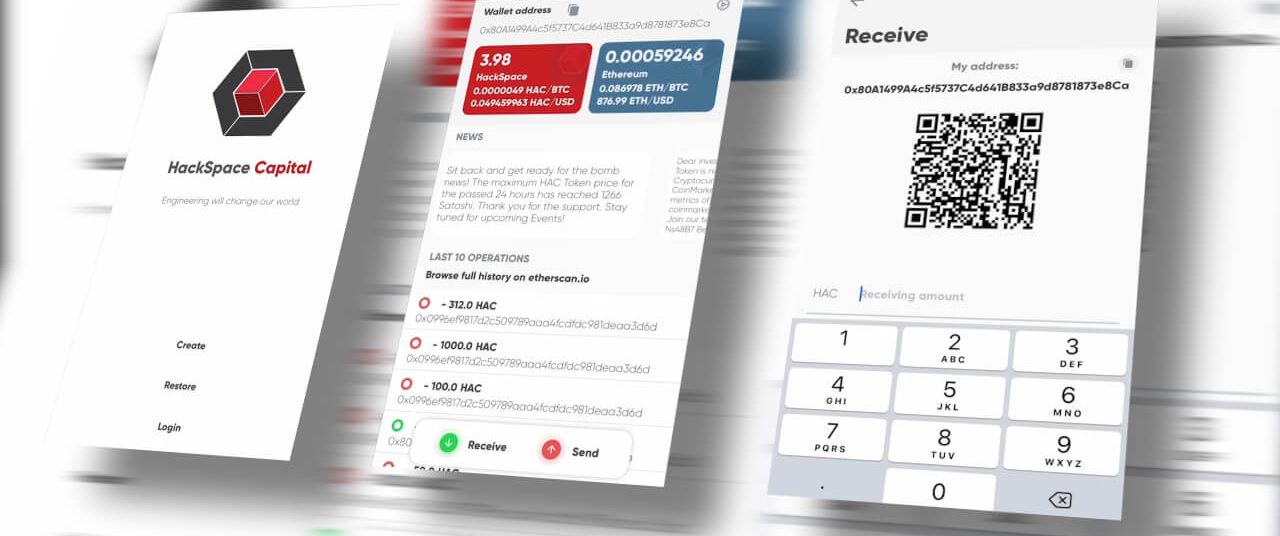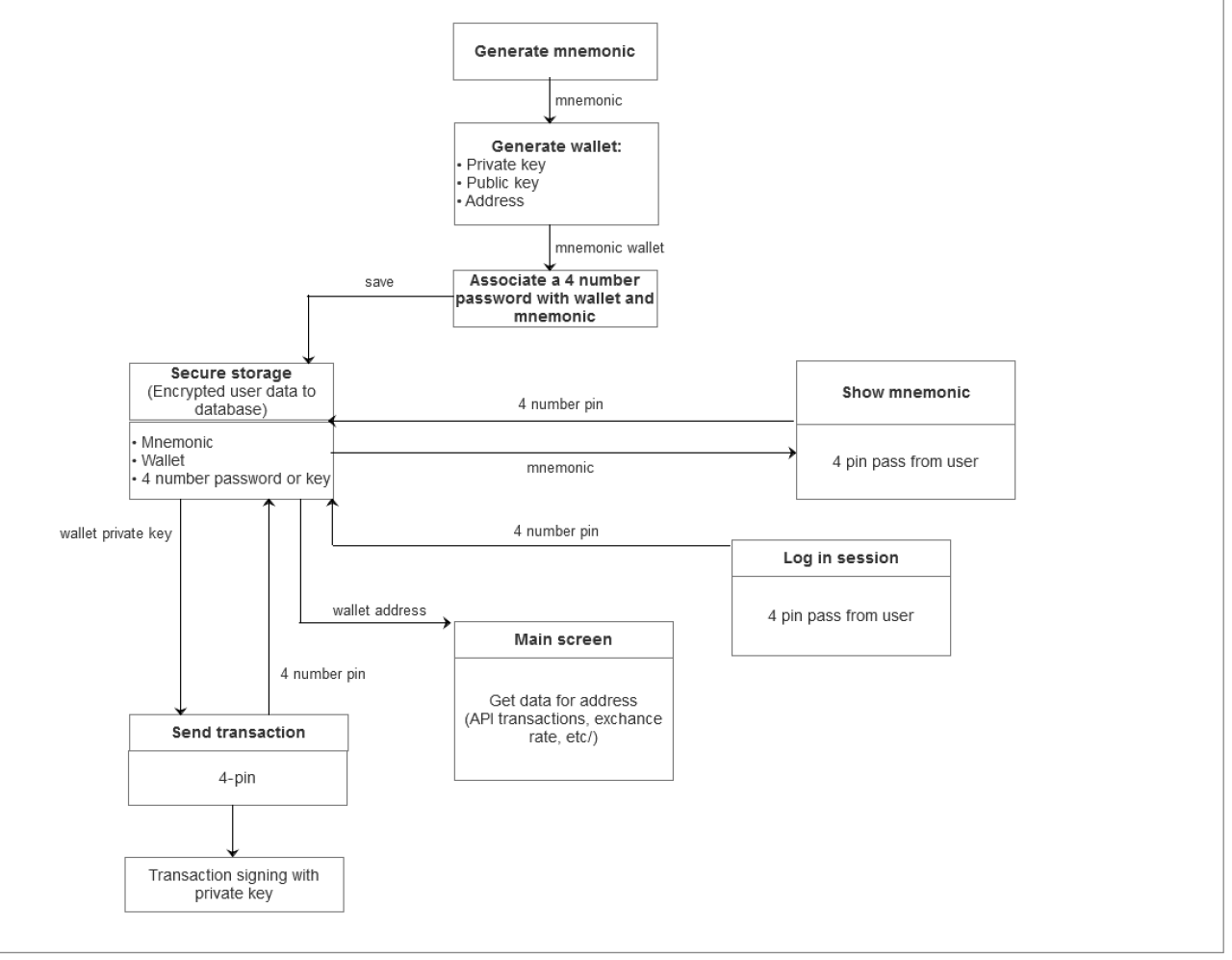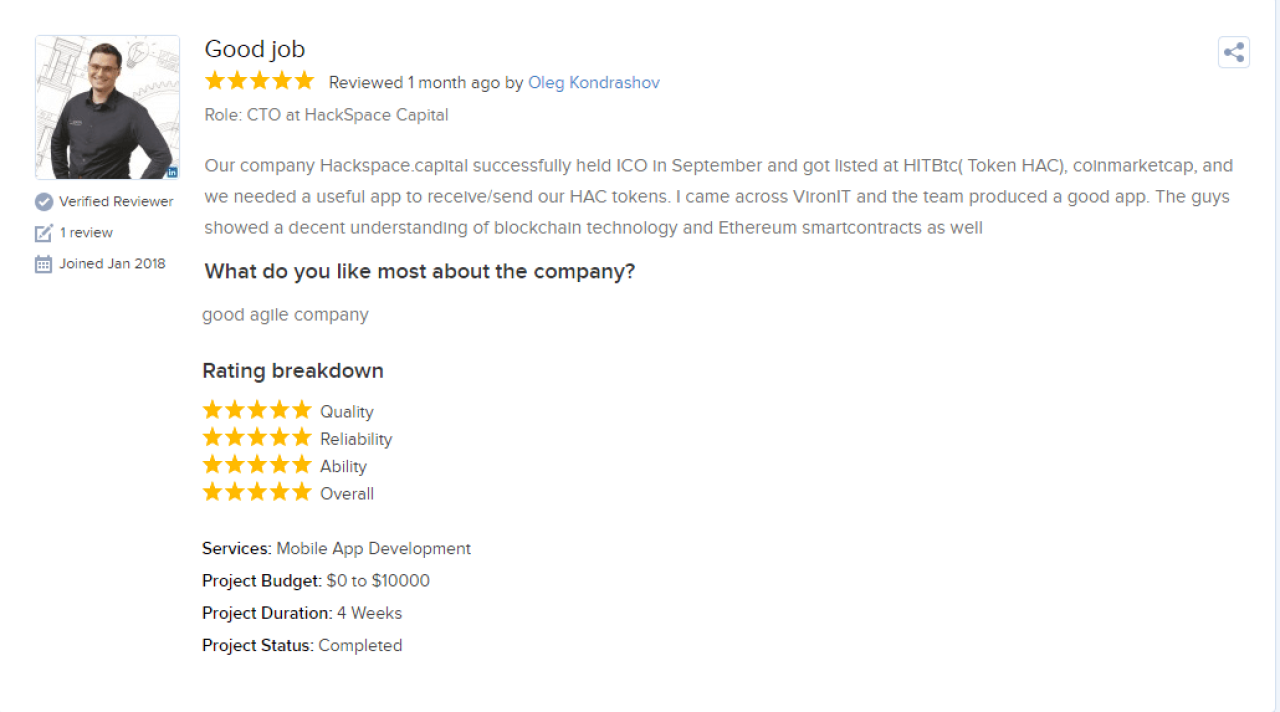How to Develop a Blockchain Wallet App

Blockchain has brought a financial revolution to the world of digital payments. In 2017, Hackspace Capital, a venture fund, launched its own ICO, and it had an idea to create the Hackspace Capital Mobile Application to make communication between HAC members and its platform more convenient and safe.
Hackspace Capital entrusted us with developing a cryptocurrency wallet in Ethereum blockchain to manage HAC tokens.
What does the Hackspace Application do?
The Hackspace cryptocurrency wallet in Ethereum blockchain is an iOS native application for managing HAC tokens. This is the best way to be part of HAC Token Sale Sessions and to manage HAC tokens safely and securely.
The app contains the following features:
- Balance and transaction history
- Exchange rates of HAC and ETH relative to BTC and USD
- A QR code to receive incoming transactions
- Ability to send tokens to another address either manually or through a QR scanning operation.

1.Login with pincode; 2. Main screen; 3. Receive screen; 4.- 6. Registration and adding pincode; 7. Send screen
Cryptocurrency Wallet Architecture in a Nutshell
This section assumes a basic understanding of Ethereum blockchain wallet architecture. If you are starting from scratch and don’t know what Ethereum is, how it works, or what an ICO is, you will be best served reading the following articles first:
- How to Build a Smart Contract for Ethereum? Guide to Blockchain Development
- ICO Smart Contract Tips
- How to Launch a Successful ICO. An Ultimate Guide
If you already know about Ethereum, we recommend you follow along.
First, let’s look at the following diagram because it illustrates a general architecture of a cryptocurrency wallet in an Ethereum blockchain. The creation of the wallet includes the generation of 12-word mnemonic and derivation private key and address from it. A four-digit code is used for quick access to the account.

A general architecture of a cryptocurrency wallet
To implement this challenge, we used the following technologies:
- Swift
- RxSwift
- Realm
- Blockchain
Registration and login
To register, we generated a mnemonic code, which is better for human interaction than raw binary or hexadecimal representations of a wallet seed. The sentence can be written on paper or spoken over the telephone.
To generate a 12-word mnemonic we used BIP39, which describes the implementation of a mnemonic code or mnemonic sentence to generate deterministic wallets. We also used BIP32, which allows us to create Ethereum accounts, namely, private and public keys and addresses. For quick access to the account, we utilized a four-digit code.
NOTE: Instead of BIP39, you can use iOS technologies. This reduces the JavaScript code and, therefore, increases your application speed.
Code Example
[code language="javascript"]
// Returns randomly generated mnemonic
window.generateMnemonic = function() {
return bip39.generateMnemonic();
}
// Checks if mnemonic valid, if yes - creates wallet with specified index (default = "0")
window.createWallet = function(mnemonic, index) {
if (!bip39.validateMnemonic(mnemonic)) {
return;
}
if (typeof index === 'undefined') {
index = "0";
}
var seed = bip39.mnemonicToSeed(mnemonic);
var hdWallet = hdKey.fromMasterSeed(seed);
var wallet_hdpath = "m/44'/60'/0'/0/";
var wallet = hdWallet.derivePath(wallet_hdpath + index).getWallet();
return wallet;
}
[/code]
Main screen
The main screen allows users to check their balance, transaction list, and the exchange rates of HAC and ETH relative to BTC and USD.
To create a transaction list and get the Ethereum balance, we used the Etherscan API, which supports both GET/POST requests and a rate limit of 5 requests/sec.
To get information about our main account balance and tokens, we used Ethplorer API.
The exchange rates of HAC and ETH relative to BTC and USD are carried out using HitBTC API, which is extremely stable and provides an easy back office integration. It is compatible with HFT set-ups and algorithmic trading systems.
Code Example
[code language="javascript"]
// Returns address from account generated from mnemonic
window.getAddress = function(mnemonic, index) {
var wallet = createWallet(mnemonic, index);
return wallet.getChecksumAddressString();
}
[/code]
Transaction acceptance
To receive incoming transactions, a QR code is created. Share the receive address or the QR code with the person sending the digital currency and receive ETH in your Ethereum wallet.
Creating and sending a transaction
We created contracts on Ethereum using JavaScript API web3.js. Under the hood, it communicates to a local node via RPC calls. To work without a local node, we used the Infura service, which provides Ethereum clients running in the cloud, so users don’t have to run one yourself to work with Ethereum.
At this point, we have to create an Infura account and receive tokens to use in the web3js constructor.
NOTE: At this stage you must specify const tokenAddress and const contractAbi.
Code Example
[code language="javascript"]
// Sends token transaction from address getted from mnemonic to specified address
window.sendToken = function(mnemonic, amount, toAddress, gasPriceGwei, gasLimit) {
// initialization (provide our Infura node with token)
var web3 = new Web3(new Web3.providers.HttpProvider("https://mainnet.infura.io/INFURA_TOKEN_HERE"));
// current wallet
var wallet = createWallet(mnemonic);
// address
var fromAddress = add0x(wallet.getAddress().toString("hex"));
// private key
var privateKey = Buffer.from(wallet.getPrivateKey().toString("hex"), 'hex');
// nonce
var transactionsCount = web3.eth.getTransactionCount(fromAddress);
var nonce = web3.toHex(transactionsCount);
// gas price
var gasPrice = web3.toHex(web3.toWei(gasPriceGwei, 'gwei'));
// gas limit
var gasLimit = web3.toHex(gasLimit);
// token contract
var tokenContract = web3.eth.contract(contractAbi).at(tokenAddress);
var data = tokenContract.transfer.getData(add0x(toAddress), amount, {from: add0x(fromAddress)});
var rawTransaction = {
from: fromAddress,
nonce: nonce,
gasPrice: gasPrice,
gasLimit: gasLimit,
to: tokenAddress,
value: "0x0",
data: data,
chainId: 0x01
}
const tx = new EthereumTx(rawTransaction);
tx.sign(privateKey);
const serializedTx = tx.serialize();
web3.eth.sendRawTransaction(add0x(serializedTx.toString('hex')), function(err, hash) {
// Asynchronous callback to iOS native environment
if (!err) {
window.webkit.messageHandlers.callback.postMessage([1, hash.toString()]);
} else {
window.webkit.messageHandlers.callback.postMessage([0, err.toString()]);
}
})
}
// Service function for adding "0x" to hex values
function add0x (input) {
if (typeof(input) !== 'string') {
return input;
}
else if (input.length < 2 || input.slice(0,2) !== '0x') {
return '0x' + input;
}
else {
return input;
}
}
[/code]
The Result
Working with Hackspace Capital helped us expand and improve our expertise in blockchain-based mobile apps. View the following video to see the results:
Client feedback

Useful links
We have created the following list of useful links during our research.
API:
- Etherscan
- List of Transactions – Get a list of ‘Normal’ Transactions By Address
- Account Balance – Get Ether Balance for a single Address
- Ethplorer
- List of Transactions – /getAddressHistory/{address}
- Account Balance – /getAddressInfo/{address}
- HitBTC
Libraries:
To summarize
Now you know what a cryptocurrency wallet is and why you need it. Moreover, you know how to create a wallet app.
If you are interested in developing a blockchain wallet and don’t want to spend time on programming, our services can be very useful. We have vast experience, and we will create a high-grade application and integrate a payment system you consider convenient. If you want more information, please contact us.





ปั๊มไลค์ says:
Like!! Really appreciate you sharing this blog post.Really thank you! Keep writing.